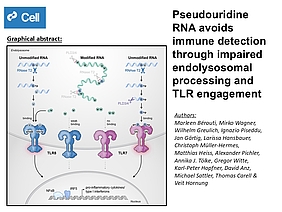New joint publication by the Carell and Hopfner labs on how pseudouridine RNA avoids immune detection through impaired endolysosomal processing and TLR engagement
Bérouti M, Wagner M, Greulich W, Piseddu I, Gärtig J, Hansbauer L, Müller-Hermes C, Heiss M, Pichler A, Tölke AJ, Witte G, Hopfner KP, Anz D, Sattler M, Carell T, Hornung V (2025) Pseudouridine RNA avoids immune detection through impaired endolysosomal processing and TLR engagement.Cell., doi: 10.1016/j.cell.2025.05.032 Link
Abstract:
Recognition of exogenous RNA by Toll-like receptors (TLRs) is central to pathogen defense. Using two distinct binding pockets, TLR7 and TLR8 recognize RNA degradation products generated by endolysosomal nucleases. RNA modifications present in endogenous RNA prevent TLR activation; notably, pseudouridine-containing RNA lacks immunostimulatory activity. Indeed, this property has been critical to the successful implementation of mRNA technology for medical purposes. However, the molecular mechanism for this immune evasion has remained elusive. Here, we report that RNase T2 and PLD exonucleases do not adequately process pseudouridine-containing RNA to generate TLR-agonistic ligands. As a second safety mechanism, TLR8 neglects pseudouridine as a ligand for its first binding pocket and TLR7 neglects pseudouridine-containing RNA as a ligand for its second pocket. Interestingly, the medically used N1-methylpseudouridine also evades RNase T2, PLD3, and PLD4 processing but is able to directly activate TLR8. Taken together, our findings provide a molecular basis for self-avoidance by RNA-sensing TLRs.
Read the full paper here: https://www.sciencedirect.com/science/article/pii/S0092867425006191?via%3Dihub

